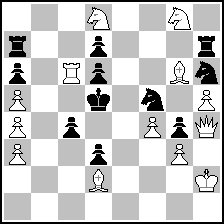|
|
| (1) Posted by Geoff Foster [Thursday, Apr 24, 2008 08:13] |
Caldas Vianna 4-mover reconstruction exercise
 (= 13+11 ) (= 13+11 )
#4
Caldas Vianna
The Chess Monthly 1881
1.Qf6! (several threats)
1...... Ke4 2.Kg2 (threat 3.Rxd6)
1...... dxc6 2.Qa1! (threats 3.Qh1+ and 3.Sf6+)
This problem has a fatal flaw - after 1...dxc6 White can also play 2.Qxf5+.
Bob Meadley has offered a book prize for the best correction. The book is "Moral Victories" by David Lovejoy - the life of GM Savielly Tartakower in novel form. Post your entries and I'll award the book to the person who contributes most to the best correction.
|
|
| (2) Posted by Vlaicu Crisan [Monday, Apr 28, 2008 14:26] |
The problem seems to be easily corrected. After spending a couple of minutes, I reached to the following version:
 (= 13+9 ) (= 13+9 )
The key is the same: 1.Qf6! but the threat is unique now: 2.Rxd6+ Ke4 3.Kg2. The main variations are:
1...Ke4 2.Kg2 with a double threat split between 2...Kd5 3.Rxd6+ and 2...dxc6 3.Qxd6. (2...Se6 which parries both threats is followed by 3.Qxf5+)
1...dxc6 2.Qa1 with a single threat 3.Sf6+ (2...Sg~ parries the threat but allows 3.Qh1+)
This is surely not the best possible reconstruction as I tried to keep it as much as possible closer to the original version, but could be used as a starting point for future improvements. Can anyone get rid of the idle wRa3?
|
|
| (3) Posted by Joaquim Crusats [Monday, Apr 28, 2008 22:26] |
Does something like this work? I think that the position is still legal.
 (= 13+8 ) (= 13+8 )
|
|
| (4) Posted by Vlaicu Crisan [Tuesday, Apr 29, 2008 22:19] |
Joaquim, in your version the wBd2 can be safely replaced by a wP!
I also liked the variation 1...c3 2.Rxd6+ Sxd6(Ke4) 3.Qe5+(Kg2).
However there is still a double threat after the key [2.Qxd6/Rxd6+]
|
|
| (5) Posted by Joaquim Crusats [Wednesday, Apr 30, 2008 14:35]; edited by Joaquim Crusats [08-04-30] |
You are right Vlaicu (my neighbour in the album), the dual threat is very annoying.
This version (in which c5 is again attacked) keeps the threat as in yours, and if the Pb3 is black then the wQ need not be necessarily en prise at the beginning. But then there are also duals in the solution. Just another idea.
 (= 11+10 ) (= 11+10 )
|
|
| (6) Posted by Vlaicu Crisan [Wednesday, Apr 30, 2008 21:48] |
You had an excellent idea, my neighbor! Hope to be again neighbors in the next FIDE albums as well! :-)
There is still some place left for improvement, because - as you rightly noticed - the key is poor (taking a flight can not be called quite "pleasant"). So let's try something else instead of the rather mediocre key 1.Qf6...
 (= 11+11 ) (= 11+11 )
What is particularly interesting in this version is the try:
1.Sc6? ~ 2.Bxf5 dxc6(Sxf5) 3.Qe5(Qxf5)+
1...Ke4(a) 2.Qa1(A) ~(dxc6) 3.Qh1(B)(Sf6(C))+
1...dxc6(x)! refutes
Key:
1.Rc6! ~ 2.Rxd6+ Ke4 3.Kg2
1...Ke4(a) 2.Kg2(X) ~(dxc6) 3.Qxd6/Rxd6+(Qxd6+)
1...dxc6(x) 2.Qa1(A) ~(Sg~) 3.Sf6(C)(Qh1(B))+
As you can see, the new key adds a modern touch to Vianna's old fashioned 4-mover. The position is barely legal and there is still one initial unprovided flight (e4), but I hope the extra play provides enough compensation for these defects.
|
|
| (7) Posted by Geoff Foster [Wednesday, May 7, 2008 07:27] |
I'll ask Bob Meadley to send the book prize to Vlaicu (I have Vlaicu's snail mail address). Thanks to all contributors!
|
|
No more posts |
MatPlus.Net  Forum Forum  Competitions Competitions  Caldas Vianna 4-mover reconstruction exercise Caldas Vianna 4-mover reconstruction exercise |
 ISC 2024
ISC 2024 Forum
Forum  Competitions
Competitions  Caldas Vianna 4-mover reconstruction exercise
Caldas Vianna 4-mover reconstruction exercise 


